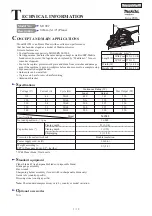
24
E N G L I S H
• The cable wire colours, or a letter, will be marked
at the connection points of most good quality
plugs. Attach the wires to their respective points
in the plug (see below). Brown is for Live (L) (2)
and Blue is for Neutral (N) (4).
• Before replacing the top cover of the mains plug
ensure that the cable restraint (3) is holding the
outer sheath of the cable firmly and that the two
leads are correctly fixed at the terminal screws.
Never use a light socket.
Never connect the live (L) or neutral (N)
wires to the earth pin marked E or
.
For 115 V units with a power rating exceeding 1500 W,
we recommend to fit a plug to BS4343 standard.
Using an extension cable
If an extension cable is required, use an approved
extension cable suitable for the power input of this
tool (see technical data). The minimum conductor
size is 1.5 mm
2
.
When using a cable reel, always unwind the cable
completely. Also refer to the table below.
Conductor size (mm
2
)
Cable rating (Amperes)
0.75
6
1.00
10
1.50
15
2.50
20
4.00
25
Cable length (m)
7.5
15
25
30
45
60
Voltage
Amperes
Cable rating (Amperes)
115
0 - 2.0
6
6
6
6
6
10
2.1 - 3.4
6
6
6
6
15
15
3.5 - 5.0
6
6
10
15
20
20
5.1 - 7.0
10
10
15
20
20
25
7.1 - 12.0
15
15
20
25
25
-
12.1 - 20.0
20
20
25
-
-
-
230
0 - 2.0
6
6
6
6
6
6
2.1 - 3.4
6
6
6
6
6
6
3.5 - 5.0
6
6
6
6
10
15
5.1 - 7.0
10
10
10
10
15
15
7.1 - 12.0
15
15
15
15
20
20
12.1 - 20.0
20
20
20
20
25
-
Assembly and adjustment
Prior to assembly and adjustment always
unplug the tool.
Replacing the cutting blades (fig. B)
The cutting blades fitted on this tool are reversible.
If both sides are worn, the cutting blades have to be
replaced.
Always replace the blades
simultaneously.
• Carefully rotate the cutterhead (7) until the first
blade becomes visible.
• Loosen the bolts (8) using the spanner supplied.
• Pull up the side guard (9).
• Slide the blade (10) out of its holder.
• Reverse the blade or replace it.
• Slide the blade into the holder. At the rebating side
(i.e. the side where the side guard is mounted),
the cutting blade must be flush with the planing
shoe.
• Adjust the blade as described below.
• Tighten the bolts (8).
• Repeat as for the other blade.
Adjusting the blades (fig. B)
• Ensure the depth of cut is set at 0 mm.
• Check the position of the blade (10) at both ends.
Use a flat object as a level across the planing shoe.
• The tip of the blade must be flush with the
planing shoe surface.
• If adjustment is required, proceed as follows:
• Turn each adjusting screw (11) in or out as
necessary until the blade tip coincides with the
planing shoe.
Adjusting the depth of cut (fig. C)
• Turn the planing depth adjustment knob (4).
One revolution of the adjustment knob equals a
4.0 mm change in depth.
Summary of Contents for D26500
Page 1: ...1 D26500 K D26501K ...
Page 3: ...3 B 5 4 3 6 2 1 A 8 9 10 7 11 ...
Page 4: ...4 C D 4 15 12 14 13 13 ...
Page 5: ...5 E F1 16 17 13 3 19 18 ...
Page 6: ...6 F2 G 19 3 20 18 21 18 3 ...
Page 7: ...7 H I 18 22 3 25 24 27 23 26 ...
Page 95: ...95 ...
Page 99: ...3 2 3 4 5 1 A ...
Page 100: ...4 14 12 10 11 14 12 10 11 A B C2 7 9 6 4 8 10 11 C1 C3 12 14 13 11 3 10 B ...
















































